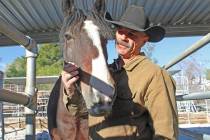Learning ABCs can prevent pool-related injuries, deaths
Although it may still be a little chilly outside, every poolgoer knows that summer is creeping around the corner. As the weather starts to warm up you start to get the itch to dive into that crystal cool water in your swimming pool, and what a fantastic way to keep cool and beat the summer heat.
Odds are the majority of people will find themselves jumping into a pool this summer. It’s important that we keep in mind some simple pool safety guidelines to make sure one of our favorite summer pastimes remains safe and prevent any unwanted accidents.
At the fire department we encourage a proactive approach to pool safety. By addressing any problems early, before they develop into a potential life-threatening situation, we can help ensure the safety of our families and friends using pools.
The ABCs of pool safety are a typical national guideline used to help set a foundation for general pool safety. Pool drownings are the No. 1 cause of death for children under the age of 5, and the majority of incidents happen in residential pools and spas.
By following some simple guidelines you can eliminate this hazard.
The ABCs of pool safety is a short acronym for: adult supervision, barriers and classes. By taking these three steps we can eradicate our pool injuries this summer.
A, which represents adult supervision, is a reminder to all pool owners to have a responsible adult present when there are people swimming. The majority of accidents in which children injure themselves while swimming, particularly those involving in a drowning, happen because of a lack of supervision.
Having an adult who knows how to swim and recognize a swimmer in distress is the first step in preventing swimming pool-related deaths. Knowing that people are in your pool is not enough to prevent accidents from happening; you must be present and supervising in order to act on a potential life-safety hazard.
B, which represents barriers, is the act of putting up physical obstacles between the pool and people, specifically children, who may find themselves accidentally falling into the pool. A gate that goes around the circumference of the pool or encloses the patio next the pool is the ideal barrier. It takes only a momentary lapse in supervision for a child to find him or herself around the pool and accidentally falling in.
If your child is old enough or strong enough to crawl and walk, he or she is old enough to accidentally find him or herself around the pool. Open doors, sliding doors and doggy doors are all ways that intuitive children can find themselves outside.
A strong fence between them and the pool could help minimize the possibility of them accidentally falling in.
C, which represents classes, is the proactive approach to learning how to be the safest you can be around the pool.
Two of the most important classes you should take are swimming lessons and CPR/first aid. It is absolute imperative that you, as an adult supervisor, know how to swim.
It does little good to supervise others in the pool if, in the event of an emergency, you are unable to rescue a struggling swimmer. Swimming lessons are offered at the Boulder City Municipal Pool and registration is through the Parks and Recreation Department.
Secondly, and equally as important, is CPR/first aid. This class teaches you how to recognize life-threatening emergencies and how to be a first responder until emergency medical services/paramedics arrive. Knowing how to perform effective CPR could be the difference between life and death. Visit the Boulder City Parks and Recreation Department to register for an upcoming class.
If you have any other questions or comments regarding pool safety, please visit abcpoolsafety.org. You can also contact me at the fire station at 702-293-9228 or email me at bshea@bcnv.org.
Brian Shea is a Boulder City paramedic/firefighter.











